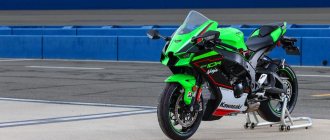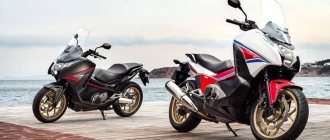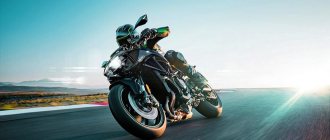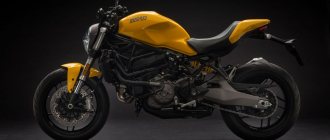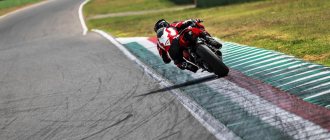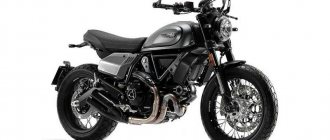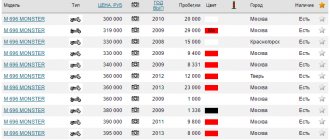| Kawasaki Z300 (2015-2018) |
The Kawasaki Z300 naked model appeared in 2015, becoming the successor to the Kawasaki Z250 in Europe, Oceania and South America. In Asian countries (including Japan), the Z250 became known as the Z250 ABS and was essentially a Z300, but with a motor from the Ninja 250 (the new Z300 model received a motor from the Ninja 300).
The Kawasaki Z300 was based on an in-line 2-cylinder liquid-cooled engine with a volume of 296 cm³ and producing 39 hp. power and 27 Nm of torque. The engine is revvy, with maximum performance at 10,000-11,000 rpm.
The frame of the Kawasaki Z300 is a steel diamond-shaped structure, the suspension is simple - a conventional 37 mm telescopic fork at the front, a swingarm with a progressive monoshock at the rear. The braking system is completely disc, there are versions with ABS.
Compared to the previous Kawasaki Z250, the new Z300 gets an Assist & Slipper clutch. The restyled Asian version of the Kawasaki Z250 ABS was also equipped with this system.
2018 was the last year of production of the Z300 model, after which it left the market, giving way to an updated model - the Kawasaki Z400.
Main competitors of Kawasaki Z300:
- Honda CB300F/CB300R
- Suzuki GW 250
- Yamaha MT-03 (2016-)
Brief history of the model
- 2015 - start of production and sales of the Kawasaki Z300 model.
Model
: Kawasaki Z300;
Kawasaki Z300 ABS (Europe, Oceania, South America, etc.). Factory designation
: ER300AFF; ER300BFF.
- 2016 - no significant changes.
Model
: Kawasaki Z300;
Kawasaki Z300 ABS (Europe, Oceania, South America, etc.). Factory designation
: ER300AGF; ER300BGF.
- 2017 - no significant changes.
Model
: Kawasaki Z300;
Kawasaki Z300 ABS (Europe, Oceania, South America, etc.). Factory designation
: ER300AHF; ER300BHF.
- 2018 - only the version with ABS is produced. Last year of production.
Model
: Kawasaki Z300 ABS (Europe, Oceania, South America, etc.).
Factory designation
: ER300BJF.
External links [edit]
- Official website (Australia)
| vte «Previous - chronology of Kawasaki motorcycles, 1990 – present | ||||||||||||||||||||||||||||||||||||||
| Year Type | 1990s | 2000s | 2010s | |||||||||||||||||||||||||||||||||||
| 0 | 1 | 2 | 3 | 4 | 5 | 6 | 7 | 8 | 9 | 0 | 1 | 2 | 3 | 4 | 5 | 6 | 7 | 8 | 9 | 0 | 1 | 2 | 3 | 4 | 5 | 6 | 7 | 8 | 9 | |||||||||
| Naked/Adventure tourism | W175 | |||||||||||||||||||||||||||||||||||||
| Estrella | W250 | |||||||||||||||||||||||||||||||||||||
| W650 | W800 | W800 | ||||||||||||||||||||||||||||||||||||
| Versis-X 250 | ||||||||||||||||||||||||||||||||||||||
| Versys-X 300 | ||||||||||||||||||||||||||||||||||||||
| KLE500 | Versys 650 | |||||||||||||||||||||||||||||||||||||
| Versys 1000 | ||||||||||||||||||||||||||||||||||||||
| Z125 PRO | ||||||||||||||||||||||||||||||||||||||
| Z125 | ||||||||||||||||||||||||||||||||||||||
| Z250SL | ||||||||||||||||||||||||||||||||||||||
| Z250 | ||||||||||||||||||||||||||||||||||||||
| Z300 | Z400 | |||||||||||||||||||||||||||||||||||||
| ER-5 | Ninja 650 / ER-6f / ER-6n | Ninja 650/Z650 | ||||||||||||||||||||||||||||||||||||
| ZR750 Zephyr | ZR-7 | Z750 | Z800 | Z900 | ||||||||||||||||||||||||||||||||||
| Z900RS | ||||||||||||||||||||||||||||||||||||||
| Zephyr 400/550/1100 | Z1000 | |||||||||||||||||||||||||||||||||||||
| ZRX1100 | ZRX1200R | |||||||||||||||||||||||||||||||||||||
| Dual sport | KL250 Super Sherpa | |||||||||||||||||||||||||||||||||||||
| KLR250 | KLX250S | |||||||||||||||||||||||||||||||||||||
| KLX450R | ||||||||||||||||||||||||||||||||||||||
| KLR650 | ||||||||||||||||||||||||||||||||||||||
| Sport | Ninja 125 | |||||||||||||||||||||||||||||||||||||
| Ninja 250SL | ||||||||||||||||||||||||||||||||||||||
| Ninja 250R | ||||||||||||||||||||||||||||||||||||||
| Ninja 400 | Ninja 300 | Ninja 400 | ||||||||||||||||||||||||||||||||||||
| Ninja ZX-2R / Ninja ZXR250 | ||||||||||||||||||||||||||||||||||||||
| ZXR400 | ||||||||||||||||||||||||||||||||||||||
| EX500 / GPZ500 / Ninja 500 | ||||||||||||||||||||||||||||||||||||||
| ZX600C-E / Ninja ZX-6 | ZX600F-J / Ninja ZX-6R | |||||||||||||||||||||||||||||||||||||
| Ninja ZX750F | ||||||||||||||||||||||||||||||||||||||
| ZXR750 / Ninja ZX-7R | ||||||||||||||||||||||||||||||||||||||
| GPZ900R | Ninja 1000 | |||||||||||||||||||||||||||||||||||||
| ZX900 / Ninja ZX-9R | Ninja ZX-10R | |||||||||||||||||||||||||||||||||||||
| Ninja H2/H2R | ||||||||||||||||||||||||||||||||||||||
| ZX-10 Tomcat | Ninja ZX-12R | |||||||||||||||||||||||||||||||||||||
| Sports tourism | ZZR600 | |||||||||||||||||||||||||||||||||||||
| GPZ1100/ZX1100E | ||||||||||||||||||||||||||||||||||||||
| ZZR1100C / Ninja ZX-11C | ZZR1100D / Ninja ZX-11D | ZZR1200/ZX-12C | ZZR1400 / Ninja ZX-14 | |||||||||||||||||||||||||||||||||||
| Ninja H2 SX | ||||||||||||||||||||||||||||||||||||||
| Tourism | GTR1000/Concours | 1400GTR / Competition 14 | ||||||||||||||||||||||||||||||||||||
| Cruiser | EL250 | EL125 / Eliminator | ||||||||||||||||||||||||||||||||||||
| 454 LLC | Vulcan VN500C | |||||||||||||||||||||||||||||||||||||
| Vulcan EN500A | ||||||||||||||||||||||||||||||||||||||
| Vulcan S | ||||||||||||||||||||||||||||||||||||||
| Vulcan VN750 | ||||||||||||||||||||||||||||||||||||||
| Vulcan VN800A / Vulcan Classic VN800B | ||||||||||||||||||||||||||||||||||||||
| Vulcan VN900 Classic / VN900B | ||||||||||||||||||||||||||||||||||||||
| Vulcan 800 / +1500 Drifter | ||||||||||||||||||||||||||||||||||||||
| Vulcan VN1500 | ||||||||||||||||||||||||||||||||||||||
| Vulcan VN1600 | Vulcan VN1700 | |||||||||||||||||||||||||||||||||||||
| Vulcan VN2000 | ||||||||||||||||||||||||||||||||||||||
| MotoGP | Ninja ZX-RR | |||||||||||||||||||||||||||||||||||||
Specifications
Technical characteristics of Kawasaki Z300:
| Model | Kawasaki Z300 |
| Motorcycle type | naked |
| Year of issue | 2015-2018 |
| Frame | steel diagonal |
| engine's type | 2-cylinder, 4-stroke, in-line |
| Working volume | 296 cm³ |
| Bore/Stroke | 62.0 x 49.0 mm |
| Compression ratio | 10.6:1 |
| Cooling | liquid |
| Number of valves per cylinder | DOHC, 4 valves per cylinder |
| Fuel supply system | Injector with double throttle valves, 2x 32 mm |
| Ignition type | transistor (TCBI with Digital Advance) |
| Maximum power | 39.0 hp (29.0 kW) at 11000 rpm |
| Maximum torque | 27.0 Nm (2.8 kg*m) at 10,000 rpm |
| Clutch | Multi-disc in oil bath, cable drive Assist & Slipper Clutch |
| Transmission | 6-speed |
| type of drive | chain |
| Front tire size | 110/70-17M/C (54S) |
| Rear tire size | 140/70-17M/C (66S) |
| Front brakes | 1 disc, 290 mm, 2-piston caliper - (ER300B - ABS) |
| Rear brakes | 1 disc, 220 mm, 2-piston caliper - (ER300B - ABS) |
| Front suspension | Telescopic fork 37 mm (non-adjustable), travel - 120 mm |
| Rear suspension | Pendulum Uni-Trak with monoshock absorber (5-stage adjustable preload), stroke - 132 mm |
| Motorcycle length | 2015 mm |
| Motorcycle width | 750 mm |
| Motorcycle height | 1025 mm |
| Wheelbase | 1405 mm |
| Seat height | 785 mm |
| Minimum ground clearance | 145 mm |
| Acceleration 0-100 km/h (0-60 mph) | 6.46 sec[1] |
| Maximum speed | 168 km/h[2] |
| Gas tank capacity | 17.0 l |
| Motorcycle weight (curb) | 168 kg – Z300A 170 kg – Z300B (ABS) |
Hi all! I decided to diversify my life experience with a trip to the sea on a motorcycle. And if so, it is necessary to make appropriate preparations, since my moped is an excellent urban naked bike, absolutely unsuitable for long-distance travel. What last year’s 150+ km coverage showed. If in the city and at the gymkhana the Zedka (Ninja 300 without a body kit and with a normal steering wheel) is just an awesome moto - nimble, nimble, economical. Then on the track a number of shortcomings emerge: the lack of space for the case, the complete lack of wind protection and, most importantly, the lack of power to hold the 150 cruiser. It was decided that some of the shortcomings would be corrected with accessories, some with the purchase of a new motor, but in the next season))
So. wind protection PUIG touringscreen Lois Edition glass was purchased in one well-known store
I didn’t find any reviews on it, but the manufacturer indicated that the glass is compatible with my motorcycle model. In principle, it turned out to be compatible, but I had to do a little magic. 1) In the form in which it arrived, the fastenings were not placed on the steering wheel - there was no room. The steering wheel itself is small, plus the brake machine on the right was in the way. I had to twist the fasteners with the supports inward. 2) due to the fact that there is practically no space between the handlebars and the fork, it is impossible to change the angle of inclination of the supports. in general, the glass could have been installed either with a wild slope, which would not have given me the opportunity to bend down at all and would have reflected the flow right into my neck, and not into the overlap of the headlights as I originally wanted.
In general, it’s easier to show what happened:
Based on the testing results, it turned out that at 100+ km/h the flow is reflected directly into the helmet - on the one hand, the load on the chest and shoulders has decreased, on the other hand, the background noise has increased significantly. this is really very unpleasant. In addition, it has now become impossible to lie down completely on the tank, since the motorcycle has a short base, and I am quite a tall guy.
mixed feelings. It seems to have gotten better, but at the same time worse. It might be worth buying an additional MRA spoiler, but I don’t want to have to go through delivery again.
What about luggage? I bought a set of givi fastenings for the central case, a kappa case and a bag for the kappa tank: There were no problems with the installation of either one. And the tank bag is great. and doesn't interfere at all. no way. Unexpectedly, the advantage of the case was the additional comfort of the second room))) Here's what happened in the end:
Well, as a final touch, adding a little power, it was decided to replace the ugly (because it didn’t fit) plastic sticker with Orthodox honeycombs: Here’s what happened in the end:
In addition, I'm waiting for a 3d mesh from Ali. I hope she comes before the trip and saves my Jo. I’ll write about the results of the trip)
Price for Kawasaki Ninja 300
Price of a new motorcycle without mileage
The cost of the new Kawasaki Ninja 300 motorcycle at the beginning of 2014 was 250 thousand rubles (before strong changes in the ruble exchange rate). Now the price of a new kawasaki ninja ranges from 330 to 395 thousand rubles:
Price for the new Kawasaki Ninja 300. Screenshot No. 1
Price for a used Kawasaki Ninja 300
How much a used model will cost is determined by the year of manufacture and technical condition. Having analyzed advertisements for the sale of used models, we can state a range from 190 to 380 thousand rubles. In addition, this is one of the most rarely sold motorcycles, which allows us to conclude: despite some shortcomings, owners are in no hurry to part with the Kawasaki Ninja 300.
Price for a used Kawasaki Ninja 300. Screenshot No. 2.
Kawasaki Ninja 300 spare parts and repairs
When purchasing this model, many people are concerned about the problem of purchasing spare parts when repairs are needed. There is no need to be afraid of this, since in large cities there are dealer centers where you can purchase everything you need at the manufacturer’s prices.
If there is no such center, any spare part can be purchased on the Internet. It will take a little longer, but it won't be difficult.
Thus, plastic for the Kawasaki Ninja 300 can be purchased as individual elements, such as a rear seat cover, side plastic, front fender, tail, front fairing, false tanks and air vents, or you can buy a complete set of monolithic construction that meets all FIM requirements. Its price will be 29,172 rubles, which is significantly lower than purchasing individual parts.
Verdict
pros
- the increased engine volume increased power to 39 hp. With.;
- comfortable fit;
- simple acceleration control;
- soft switching and dosage of controls;
- the presence of a slipper clutch;
- excellent maneuverability;
- appearance.
Minuses
- weak front brake. If the Kawasaki Ninja 300 is equipped with an ABS system, then this problem is removed;
- hard seat;
- when making sharp turns, the motorcycle stops filtering road irregularities;
- Some of the most common breakdowns include failure of the ABS system, burnout of ignition units and malfunctions of the sensor for the non-retracted running board.
